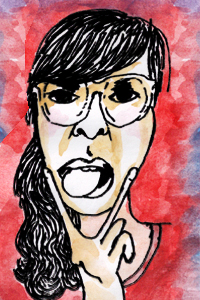
Larissa Pham is an artist and writer living in Brooklyn. She co-edits the blog at Full Stop, where she writes a monthly column about the emotional landscape of technology and the Internet.
If you’ve never seen a burial, you ought to know it’s a very labor-intensive process. There is the grave, which is a pit in the earth that seems more shallow than it should — I am used to cartoon pits, yawning abysses, but a grave ends. Inside the grave it is mostly earth and clay, and nothing, or my grandmother’s vault, if you are watching my grandfather being buried beside her. The grave has been dug before, by a bulldozer, as if to extend the myth to the grieving family that all has been in place already. Death is natural. The bulldozer is parked away from the grave, at a respectful distance, like a giant, muscular animal observing the dead.
If there is a vault, the coffin is borne by six strong men from the hearse to the vault. Then, it is lowered in with straps, which are pulled out from under. The lid is lowered onto the vault. The vault is lowered into the grave and dirt is piled above it; it takes more dirt to fill a grave than one might expect.
This process takes a long time, though not so long as it might take were it to be done by hand, as it used to be done, as it is still done in some places. It is all accomplished with the help of a number of machines and the men who operate them. There is the machine that picks up the heavy metal lid of the vault and closes it upon the coffin. That same machine picks up the vault through an ingenious kind of suspension, and lowers it into the grave by the same precarious set of cables. Then our old friend the bulldozer comes back to fill the grave, scoop by scoop of wet earth, and tamps the soil down, and evens out its surface with its rake of prongs, and tamps it down again, as gently as a hand.
We watched my grandfather’s burial in the Pacific Northwest cold, it was very early January and everyone in heavy dark coats. My mother echoed my thoughts: “It’s like a hand,” she said. We observed the bulldozer at work. We were holding burning incense and the sky was pale and gray. My grandfather was a poet; he wrote a poem about such a sky. When I was much younger, I read it aloud in English for him at a poetry reading that I have few memories of, except that it was very warm and I wore a green dress. Now my favorite old man on earth was underground and the bulldozer with its giant paw was tucking him under a blanket of turf. I thought to myself, “What a tender machine.”
There are many ways in which robots create this kind of tenderness. I suppose in some ways the humans are not so very far off, or they make a constellation of actions that yield this overall effect. I learned of my grandfather’s passing via text. It was 3:30 a.m. on the west coast and my brother was standing at his bedside, but I was in New York, in my own bed, and I was supposed to go to work in two hours. I called my brother. He told me everything would be okay. I talked to my mother and she cried. I texted my best friend and my ex. I cried too and then when I stopped crying the first thing I did was open Chrome and search for “grief.” I was, like all lost things, looking to be told what to do.
The first result at the top of the page was a link to a Wikipedia entry, which I skimmed until I found the thing that looked like me. Here it is:
Nomads: Nomads have not yet resolved their grief and do not seem to understand the loss that has affected their lives.
The lost thing looks for the thing that resembles herself in the unfamiliar landscape of grieving. If you search Google trends, you’ll find that the first related search term for “grief” is “stages of grieving.” We just want to know what will happen, and how the pain will feel; what to know, how to prepare, and yes, this is all normal. There was a comfort in both these things: in a digital search yielding so quickly to the touch, in the unexpected empathy of the Internet. It is good, sometimes, to be told what to do.
I wonder if there’s an app for grief. Wait, I just checked: there are sixty-six. This is useful.
At about two o’clock I hadn’t managed to get myself out of bed. My ex called me and asked how I was doing and I said, “Please tell me to get out of bed and feed myself.” He did and so I put my headphones in and tucked my phone into the waistband of my underwear, where it rested like a totem against my iliac crest. I cooked myself a meal with his voice in my ear, the headphone cord tangling with the handles of my pots and pans; my phone grew warm on my stomach. I sat down with my lunch and he was there too, telling me bad jokes to get me to eat.
“You shouldn’t be alone,” he had said, and really, I wasn’t. When I closed my eyes it felt as though there was someone there with me — this was a trick that we’d played when we were together, closing our eyes on the phone and pretending we were next to each other — and all of a sudden there was room in my grief to breathe. I could feel him even in the static, in the silence. After eating I crawled back into bed and we talked until I felt human again.
The distance felt by death obviously narrows with proximity but technology also acts as a direct vector of memory. A day or two after my grandfather passed, my mother sent me a photograph of my grandparents, her parents, with the request — “Can you remove the shine from Grandma’s glasses?” and I said yes. I asked my mother for a picture of my grandmother smiling, so that I could use it as a reference.
There are few feelings stranger than sitting in bed in your underwear, photoshopping a snapshot of your dead grandparents. I copied my grandmother’s eyes from the jpeg my mother sent; zoomed in and skewed, blurred, and stretched. I set the layer to transparent so I could be sure that I was correctly placing it, then flicked opacity back and forth like a switch to see if it worked. I painted in shadows and left a tiny glimmer of glare so that the lighting looked realistic. I erased the extra parts. Then I zoomed out and there were my grandparents smiling at me, natural as a photograph, my grandmother’s eyes bright. I wondered what I had conjured. I felt halfway between mourner and witch.
On the plane back to Portland, its first iteration, I was aching with grief and my immune system was shot and I didn’t know it then, but I would be painfully sick for the next six days. The day of travel was long and terrible and I wanted to scream whenever someone was insensitive to me, which was often. And I wanted to wear my grief like a banner on my face. I wanted some kind of great signifier but none was present. I wanted everyone to know that I was grieving so that they might be gentle, but I knew that I didn’t want to deal with the sympathy of strangers, their pity or their unease. I wanted something plain and clean. I wanted a robotic, distanced tenderness. And I realized then that machines are gentle more often than humans and the truth is, we are here to die and they are here to aid us. To ease us into life and to ease us into death and to comfort the ones we leave behind, allowing the living to mourn and cross great distances. I arrived in Portland safely, after all.
This post may contain affiliate links.







